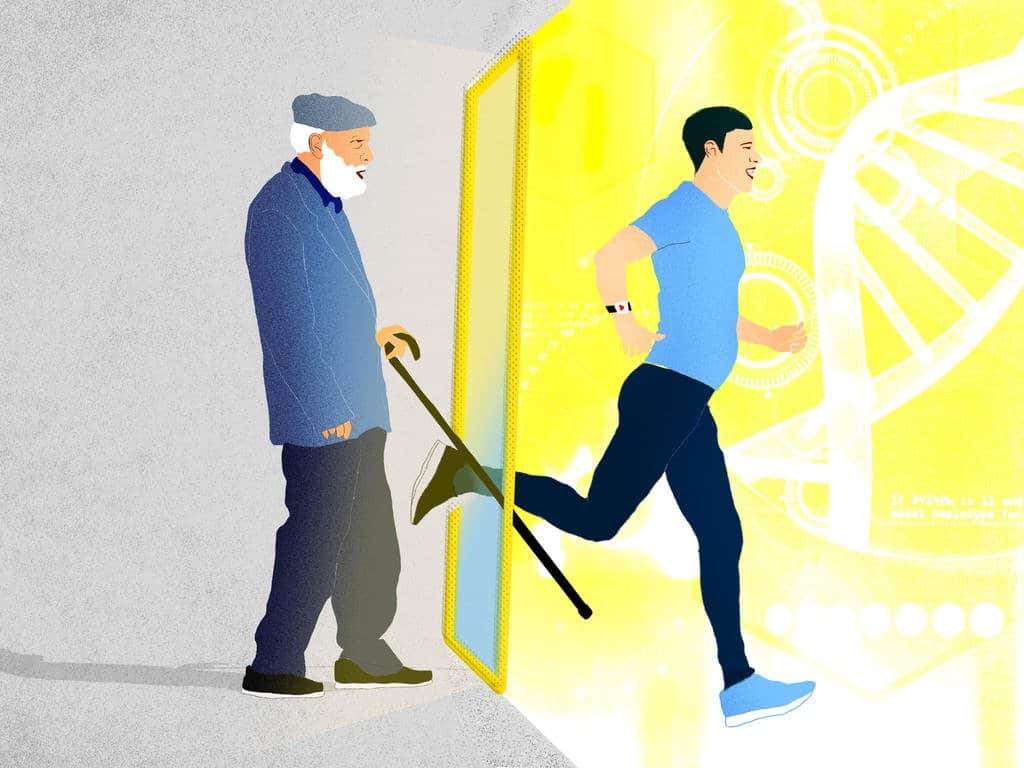Seattle-based Oisín Biotechnologies is creating therapies to fight many age-related diseases. Its revolutionary gene therapy platform erases senescent cells extremely precisely. Promising preclinical studies show significant extensions in average lifespan.
Oisín's approach has been shown to efficiently eliminate senescent cells throughout the body in mice and multiple animal models. Regenerative therapy has brought a therapeutic benefit in both disease burden and lifespan.
The treated mice lived 20% longer even when treatment began at an older age, and after a single treatment, the removal rates of senescent cells reached 70%.
The road to longevity.
The Oisín platform promises to be much safer and cheaper than other delivery systems such as viral approaches, and with reliable and reproducible regenerative therapy.
If the human trial phase is successful and the technology receives regulatory approval, this promising rejuvenating therapy will potentially be available in just 5 years. It is an approach that would be impossible to implement with current drugs.
Oisín's Regenerating Approach: A Third Wave Therapy
Le first wave therapies for diseases like cancer they included radiation and chemotherapy agents that killed everything they touched. The second wave therapies they focused on antibodies to stimulate immune cells to kill tumors, with some harmful side effects. The third wave therapies they can treat diseases without damaging healthy cells and without harmful side effects.

Oisín is pursuing a scientifically sound and targeted approach that may have the potential to address the biological underpinnings of some of society's most devastating age-related diseases.
Matthew Scholz, co-founder and CEO, Oisín Biotechnologies
Software written in the DNA
In extreme, crude summary: Oisín's regenerative therapy programs DNA to kill senescent or cancerous cells. Cells targeted are selectively killed while surrounding cells are not damaged.
Oisín kills damaged cells based on their transcriptional activity. The approach company it is based on the idea that damaged cells “know” that they are damaged and that this knowledge can be exploited to “convince them to kill themselves”.
Instead of using traditional drugs to poison damaged cells, regenerative therapy aims to program the damaged cells to self-destruct.
Programmable self-destruction is an optimal method for curing diseases because it does not harm the body with toxic chemicals.

First objective and future steps
Oisín's team chose kidney disease as their prime target, with three particular reasons in mind. First, the kidney is a target on which this approach (based on the transfection) works particularly well, as do the lung and liver. Secondly, the clinical reading of efficacy is easy, non-invasive and specific. Third, there have been few real innovations in kidney disease over the last 30 years: this increases the need for action in this field.
Oisín's rejuvenating therapy could treat many diseases and aim for more than just senescence. The team is also examining fibrotic diseases, sarcopenia and chemotherapy-induced damage as potential next targets. Three years ago the company created OncoSenX, a specific laboratory to focus on advancing its technology for oncology applications. OncoSenX targets solid tumors by using genetic information to induce apoptosis (cell death) in cancer cells.
Cellular repair therapy for longevity
Oisín predicts that the rejuvenating therapy would include several treatments. First a vigorous initial phase of therapy, then a maintenance dosage.
The rate of cell death is highly dependent on the type of tissue and the dose. It is not yet known what percentage of senescent cells will be eliminated in humans and how long it will take to reach previous levels.
They will learn more about how the treatments translate to humans during human trials.
Regenerating therapy: in summary all the improvements obtained in the studies on mice
in 2019, 41 mice were treated with Oisín targeted therapy. The mice were about 2 years old: the equivalent of a 75-80 year old human. There was a 20% increase in average survival.
in 2020 Oisín has begun a much larger study aimed at functional improvements, not just the effects on lifespan. The study is ongoing and is showing very promising results.
Obviously, direct comparisons between mice and humans are not perfect due to aging kinetics and differences in efficacy. According to the Jackson laboratory itself, a median survival of 20% in humans would translate into a potential increase in lifespan from 78 to 94 years.
In summary: if Oisín therapy behaves in humans as it does in mice, it will increase our average lifespan by about 16 years.
The results of regenerating therapy
Longer lifespan in natural-aged mice
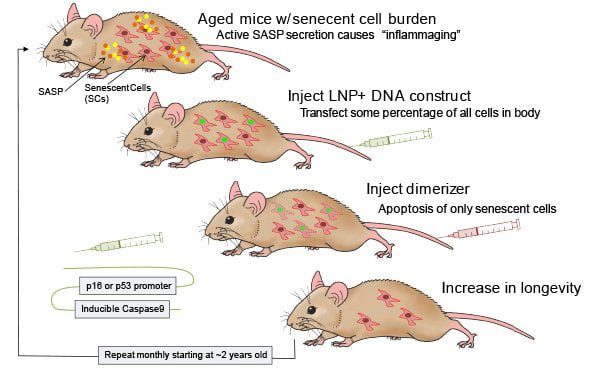
These studies showed a significant increase in survival during middle age. Remarkable and unprecedented is what happened when the team combined rejuvenating old age therapy with their cancer treatments. The synergy that has been created, say the scientists, suggests an overlap of cancer and senescence.
Significant increase in bone density
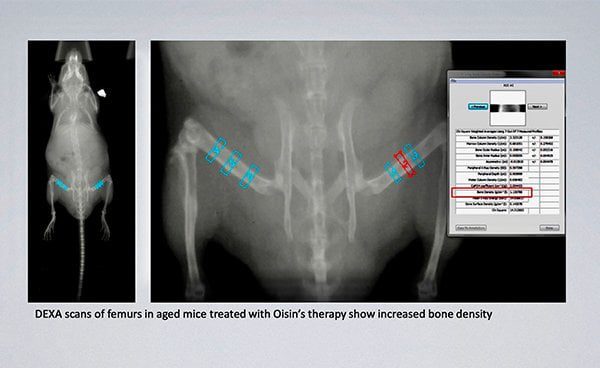
Another notable finding: Age-related bone density loss was effectively prevented in male mice.
Reduction of solid tumors
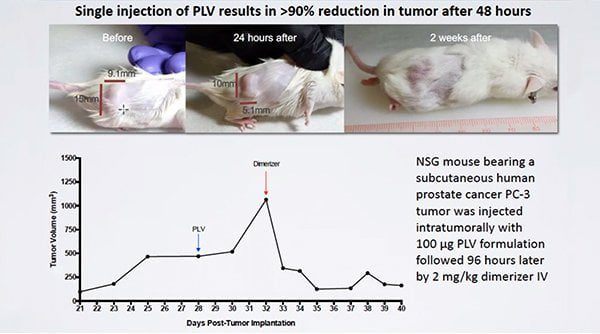
There's little to go around here: a single injection produced a 90% reduction in solid tumors after 48 hours.
Clinical approach of Oisín
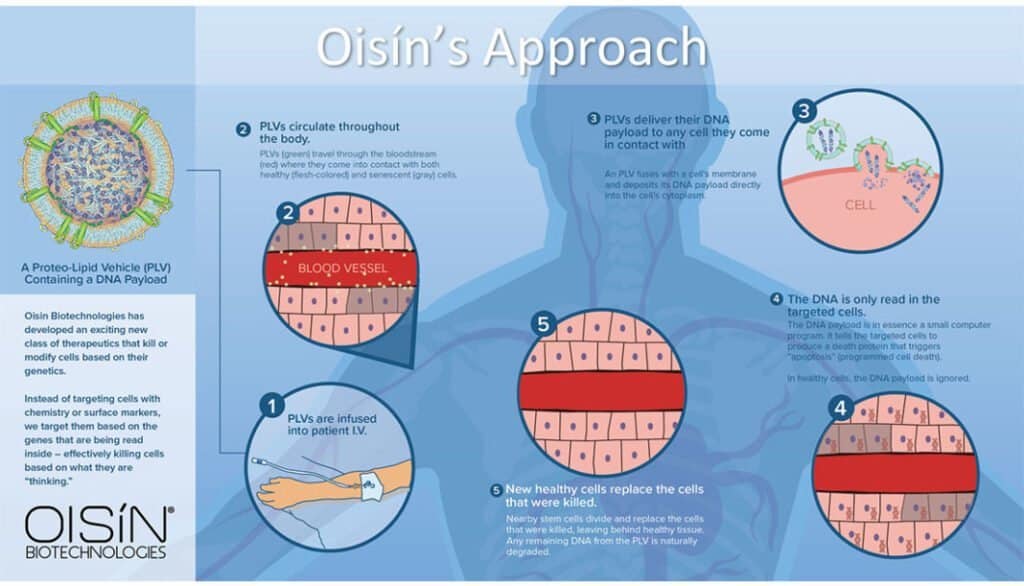
What is it about? 1 - Proteo-lipid vehicles (PLVs) containing plasmid DNA are administered intravenously and distributed widely throughout the body. 2 - PLVs fuse with any cell they come in contact with and release their DNA payload directly to the cytoplasm. 3 - The DNA payload encodes the Caspase 9 inducible suicide gene which is activated only in senescent p16 + cells 4 - cells are killed via apoptosis. 5 - Dead cells are replaced by new healthy cells.
Our approach is pretty much the exact opposite of the traditional pharmaceutical approach. With our approach there are no drugs, no poisons, just a small program written in the DNA. We have effectively brought targeting out of the realm of chemistry and into the realm of information.
Matthew Scholz, co-founder and CEO, Oisín Biotechnologies
Regenerating therapy: future functional studies
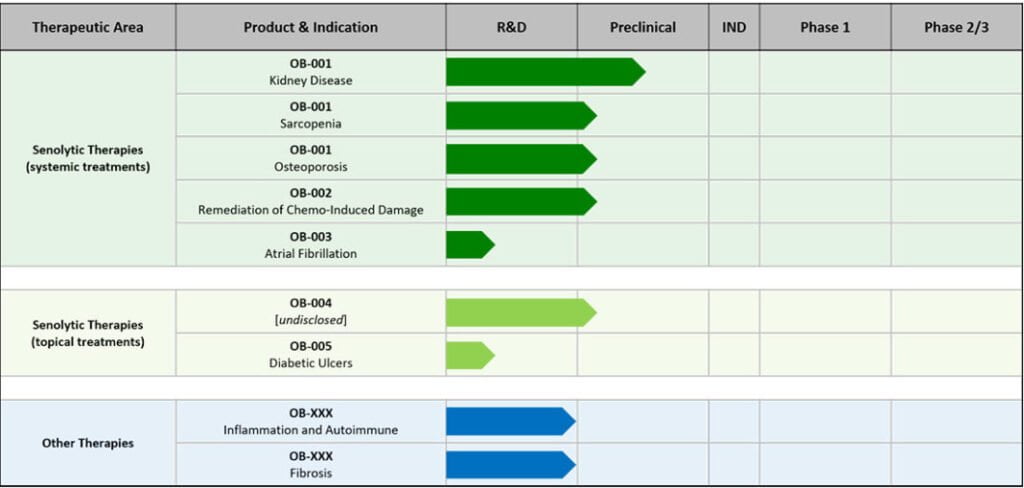
The company is now turning to functional studies and disease models to create a clinically approved therapy.
If all goes well, we are 5 years away from a revolution in the field of longevity.
